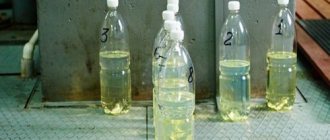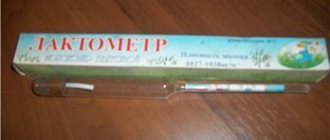Table values
Basic measurements for diesel fuel are carried out at an ambient temperature of +20C. This is due to GOST. You should also take into account the brands of fuel, because they have their own physical characteristics. If you need a value regardless of temperature, you can find it out from the following table.
| Brand name | Density, kg/m3 | Measurement temperature, C |
| Summer d/t | 860 | +20 |
| Winter d/t | 840 | +20 |
| Arctic d/t | 830 | +20 |
Based on the values, it is obvious that the density of winter diesel fuel is clearly less than the parameter for the summer grade of fuel. This ensures better fluidity of the liquid and reduces its pour point.
According to established standards, a summer grade should, under normal conditions, have a specific gravity of 8440 N/m3. A similar indicator for winter d/t is determined as 8240 N/m3.
You can independently weigh a clearly measured liter of fuel. It should reach the scale mark of 830-860 g, depending on the type.
It is worth knowing that summer diesel fuel in our country is marked with the letter “L”.
In the Middle Zone, this type is offered at gas stations from April to early to mid-autumn. It is important that the ambient temperature is not recorded below -5C (at -6C cloudiness occurs). When the value drops below -7-8C, the risk of liquid freezing increases significantly. As a result, blockages occur in the pipelines.
The density of diesel fuel varies slightly depending on temperature (the table of brands is indicated above). One degree leads to a change in density by 0.75 kg/m3. A more detailed plate can be downloaded from the link.
This is interesting: What is the volume of oil in a Nissan Qashqai engine
Physical characteristics of diesel
Diesel fuel refers to products obtained after distillation of oil at special enterprises (refineries). The quality and composition of the finished liquid must meet strict standards. The density value is a parameter that is involved in determining the productive performance of the fuel under various conditions.
It is important to know that density demonstrates the number of kilograms of liquid in one cubic meter.
Experts know that this parameter is not constant and depends on external factors, the main one of which is the ambient temperature. A rise in the thermometer stimulates a decrease in density, and the reverse process increases the specific gravity of diesel fuel.
To obtain a specific value, a measuring device is used - a hydrometer. During the measurement process, the unit must be lowered into a container with diesel fuel. To carry out measurements in different liquids, different types of hydrometers are used. Measurements in petroleum products are carried out using models AN, ANT-1 or ANT-2 .
The hydrometer is made in the form of a glass tube, inside of which there is a graduated vertical scale. A greater degree of immersion demonstrates a lower density and vice versa.
We recommend: Why is diesel oil in the intercooler?
The increased specific gravity of the liquid is a consequence of the fact that it contains heavy hydrocarbon fractions. Because of this, the high-quality operation of the internal combustion engine may decrease, because the evaporation of the liquid deteriorates and its good atomization by the nozzles is not ensured. An additional negative from the presence of a large number of heavy particles is that soot and various deposits form on the working surfaces.
The main thing is that the car drives
When buying diesel fuel at gas stations, we are hardly interested in its density, especially in the summer, the main thing is that the car drives well, and as long as everything is fine, we don’t worry about anything. But summer ends, autumn comes, then winter, and here the density of diesel fuel can play a key role in the fate of your car, and sometimes yours.
After all, many people know about the ability of diesel fuel to wax in severe frosts and turn into a liquid slurry, which clogs not only the fuel filters, but also the entire fuel system. If you have summer diesel fuel, then a sudden change in weather can lead to bad consequences.
Of course, it is, of course, impossible to determine by eye whether you are pouring summer or winter diesel fuel into the fuel tank; here you can only trust the documents, in particular the fuel passport.
Production of Arctic fuel according to GOST
In the production of Arctic diesel fuel at oil refineries, various methods are used: enzymatic dewaxing, reducing the boiling point temperature and adding depressant additives. They all have their shortcomings. Experts mention the low availability of additives from domestic manufacturers, which can reduce the price of the final product, as well as a decrease in the depth of oil refining.
Traditional methods for making wind tunnels
The main method of obtaining Arctic diesel fuel remains its production by direct distillation of oil with the release of the so-called diesel part. At the subsequent technological stage, secondary distillation with dewaxing, hydrotreating and compounding of the dewaxed fraction is performed on a special system. In addition, additives are used to increase cooling properties.
Alternative method
Along with traditional distillation methods, the Gas-to-liquids (gas to liquid) technique can be used in the production of Arctic diesel fuel. In this case, synthesizing clusters are installed in places of active oil production. Among the advantages of the method, there is a reduction in the cost of extracting Arctic fuel, the ability to highly efficiently process associated petroleum gas, and an increase in the environmental friendliness of the extraction and utilization mechanism.
State standard (GOST)
There is a GOST, according to which the density of diesel fuel should be:
- 860 kg/m3 - density of summer diesel fuel;
- 840 kg/m3 - density of winter diesel fuel;
- 830 kg/m3 - density of active diesel fuel.
These density standards must be met at a temperature of +20C. Winter fuel for diesel engines has a lower density, which means greater fluidity and the ability to not freeze in cold weather. Therefore, many drivers of diesel cars have trouble starting when they do not have time to fill the appropriate fuel in time.
Diesel fuel specific gravity standards:
- 8440 N/m3 (Newton per cubic meter) - this is for summer diesel fuel;
- 8240 N/m3 - this is for winter solarium.
What does this mean?
Specific gravity says that 1 liter of diesel fuel will weigh 830 to 860 grams, depending on the temperature and seasonal classification of the fuel.
Why does diesel fuel consumption increase in winter?
In fact, the density of diesel fuel indicates how much energy the fuel will release. The higher the density, the more energy it will release. The coefficient of performance (COP) will be higher if the fuel density is higher.
In cold climates it is necessary to fill in winter diesel fuel. It has less density so that it does not harden and has good atomization.
Some truckers advise that if diesel fuel is frozen, add kerosene to it. I don’t know how this will affect the operation of the power unit, but I think it’s better to fill in diesel fuel in advance according to seasonality. There are also special additives, antigels for diesel fuel.
If you fill in summer diesel fuel, it clogs the fuel filter in cold weather. Then you will have to disassemble and clean.
Density of diesel fuel in summer and winter
Fuel density is a variable value. It directly depends on the temperature of diesel fuel and air. A decrease in temperature leads to a decrease in density, an increase leads to an increase.
An increase in density makes the fractional composition heavier. The density of summer and winter diesel fuel is regulated by GOST R 52368-2005 and GOST 305-82.
The density of diesel fuel, depending on the time of year, is established by state standards as follows:
- winter – 860 kg/m3;
- summer - 840 kg/m3;
- Arctic – 830kg/m3.
Based on this, the weight of one liter ranges from 830 to 860 grams. As the temperature increases by one degree Celsius, the weight of diesel fuel will decrease.
Calculation of density of petroleum products
When buying and selling diesel fuel or any petroleum products, different units of measurement are used - liters and kilograms. These two parameters are interrelated, and they depend on the density of the fuel.
The density of a fuel is its specific gravity, namely the amount of mass per unit volume.
The density of the fuel largely depends on the density of the oil from which it is obtained. According to GOST R 52368-2005, the fuel density at a temperature of +15 °C should be in the range of 0.820-0.845 g/cm3, and according to GOST 305-82 it should not exceed 0.860 (at 20 °C)
The density of the fuel depends on the temperature, however, as for any other liquid: as the temperature increases, the density of the fuel decreases and vice versa - as the temperature decreases, the density of the fuel increases. There are special tables for converting fuel density depending on temperature. For diesel fuel, the temperature correction for density changes is, on average, 0.0007 g/cm3 per 1°C.
DENSITY OF PETROLEUM PRODUCTS
| PETROLEUM PRODUCTS | Density at 20* C, g/cm3 |
| Aviation gasoline | 0,73-0,75 |
| Automotive gasoline | 0,71-0,76 |
| Jet fuel | 0,76-0,84 |
| Diesel fuel | 0,80-0,85 |
| Engine oil | 0,88-0,94 |
| Fuel oil | 0,92-0,99 |
| Oil | 0,74-0,97 |
| Table of average temperature corrections for the density of petroleum products | |||
| Density at 20 °C | Temperature correction per 1 °C | Density at 20 °C | Temperature correction per 1 °C |
| 0,6500–0,6590 | 0,000962 | 0,8300–0,8399 | 0,000725 |
| 0,6600–0,6690 | 0,000949 | 0,8400–0,8499 | 0,000712 |
| 0,6700–0,6790 | 0,000936 | 0,8500–0,8599 | 0,000699 |
| 0,6800–0,6890 | 0,000925 | 0,8600–0,8699 | 0,000686 |
| 0,6900–0,6999 | 0,00091 | 0,8700–0,8799 | 0,000673 |
| 0,7000–0,7099 | 0,000897 | 0,8800–0,8899 | 0,00066 |
| 0,7100–0,7199 | 0,000884 | 0,8900–0,8999 | 0,000647 |
| 0,7200–0,7299 | 0,00087 | 0,9000–0,9099 | 0,000633 |
| 0,7300–0,7399 | 0,000857 | 0,9100–0,9199 | 0,00062 |
| 0,7400–0,7499 | 0,000844 | 0,9200–0,9299 | 0,000607 |
| 0,7500–0,7599 | 0,000831 | 0,9300–0,9399 | 0,000594 |
| 0,7600–0,7699 | 0,000818 | 0,9400–0,9499 | 0,000581 |
| 0,7700–0,7799 | 0,000805 | 0,9500–0,9599 | 0,000567 |
| 0,7800–0,7899 | 0,000792 | 0,9600–0,9699 | 0,000554 |
| 0,7900–0,7999 | 0,000778 | 0,9700–0,9799 | 0,000541 |
| 0,8000–0,8099 | 0,000765 | 0,9800–0,9899 | 0,000528 |
| 0,8100–0,8199 | 0,000752 | 0,9900–1,0000 | 0,000515 |
| 0,8200–0,8299 | 0,000738 |
In order to determine using this table the density of an oil product at a given temperature, it is necessary:
find the density of the petroleum product at +20 °C from the passport;
- measure the average temperature of the cargo in the tank;
- determine the difference between +20 °C and the average temperature of the cargo;
- using the temperature correction column, find the correction per 1 °C, the corresponding density of this product at +20 °C;
- multiply the temperature correction of the density by the temperature difference;
- subtract the product obtained in paragraph “d” from the density value at +20 °C if the average temperature of the oil product in the tank is above +20 °C, or add this product if the product temperature is below +20 °C.
Example No. 1
The density of the oil product at +20 °C, according to the passport, is 0.8240. The temperature of the oil product in the tank is +23 °C. Determine the density of the petroleum product at this temperature from the table.
We find:
- temperature difference 23 °C – 20 °C = 3 °C;
- temperature correction per 1 °C according to the table for a density of 0.8240, amounting to 0.000738;
- temperature correction per 3 °C: 0.000738 × 3 = 0.002214, or rounded 0.0022;
- the desired density of the oil product at a temperature of +23 °C (the correction must be subtracted, since the temperature of the cargo in the tank is above +20 °C), equal to 0.8240 - 0.0022 = 0.8218, or rounded 0.8220.
Example No. 2
The density of the petroleum product at +20 °C, according to the passport, is 0.7520. The temperature of the cargo in the tank is –12 °C. Determine the density of the petroleum product at this temperature.
We find:
- temperature difference +20 °С – (–12 °С) = 32 °С;
- temperature correction per 1 °C according to the table for a density of 0.7520, amounting to 0.000831;
- temperature correction for 32 °C, equal to 0.000831 × 32 = 0.026592, or rounded 0.0266;
- the desired density of the oil product at a temperature of –12 °C (the correction must be added, since the temperature of the cargo in the tank is below +20 °C), equal to 0.7520 + 0.0266 = 0.7786, or rounded 0.7785.
Examples of diesel fuel density at different temperatures
To determine the density of diesel fuel at a certain temperature you need:
- In the passport data, find the density of the petroleum product at +20 degrees Celsius.
- Measure the actual temperature of diesel fuel in the container for transportation or storage.
- We multiply the temperature difference by a factor of 0.0007.
- Let's make an amendment. If the temperature is higher, we subtract the value from the passport density; if it is lower, we add it.
This is interesting: How to refuel a car at Lukoil
Why use Arctic fuel in winter?
The use of Arctic diesel fuel directly is due to the presence of special substrates that resist freezing and maintain the required performance characteristics.
Transportation of Arctic fuel
If we compare summer and Arctic diesel fuel, then in the first case, with a decrease in temperature, thickening of the waxy mass is observed. As a result, a suspension forms in the diesel fuel, and the fuel itself begins to become cloudy. This can lead to the formation of sludge.
In other words, the resulting large paraffin microparticles clog the pores of the fine filter.
As a result, summer diesel fuel stops getting into the engine.
In order to avoid such difficulties, Arctic diesel fuel is used.
Diesel fuel classification
To classify diesel fuel, two indicators are traditionally taken into account: the degree of sulfur content and the maximum cloud point. This is a standard adopted by the state, corresponding to the European system and specification EN 590. For the purposes of this article, temperature indicators are of greatest importance.
“Temperature” classification divides fuel into grades and classes, which are indicators of the lowest temperature at which the fuel can pass through the filter.
The maximum filterability temperature (t °C) is indicated in parentheses.
| For areas with temperate climates, fuel grades are determined | Fuel classes are determined for cold climate areas |
|
|
Depending on temperature indicators, diesel fuel is divided into three main types and one additional (last).
- Summer diesel fuel. Remains liquid down to -5 °C. Recommended for use at temperatures above 0 (filterability t °C is not determined).
- Winter diesel fuel. It should not thicken to temperatures below 35 degrees. Use in frosty conditions (-20 °C).
- Arctic diesel fuel. Recommended for severe frosts from -45 degrees (-38 °C).
- Interseasonal diesel fuel (-15 °C).
Additionally, we advise you to read the material, which describes in detail the features of using antigel for diesel fuel.
For each of the three main types, its own standards for density and viscosity indicators are determined. It is these characteristics that determine the efficiency of the engine and when and what fuel to use. They are also often used to determine the quality of diesel fuel.
The viscosity standards are as follows:
- summer type - 3.8/6.0 cSt;
- winter type - 1.8/5.0 cSt;
- Arctic type - 1.5/4.0 cSt.
Density indicators will be discussed further.
Converting fuel from liters to tons
Fuel of all brands is supplied by wholesale companies in tons.
It is sold retail in liters, so the issues of converting weight to volume and vice versa are relevant, mainly for accountants of enterprises working in this business, and tax services overseeing the correct calculation of taxes on sales volumes. An ordinary buyer of fuel for his car is rarely interested in these subtleties, since he pays for liters both in summer and winter.
Conversion formulas
The volume and mass of a liquid are related by the formula: M = V ρ,
where M is the mass of the liquid in tons, V is its volume in m³, ρ is the density in t/m³.
In real practice, managers prefer to deal with tons (fuel purchases) and liters (sales). If the above formula is expressed in terms of these quantities, it will look like this:
M = V ρ /1000
- where ρ is the density of the liquid in kg/l (numerical value),
- V – volume of liquid in liters;
- M – mass of liquid in tons.
To find out, for example, how much 1000 liters of diesel fuel with a density of 0.83 kg/l weigh, we substitute the values in the formula to obtain the mass in tons:
M = 1000 · 0.83 / 1000 = 0.83 t.
https://youtube.com/watch?v=9-sCkhkgNcw
The reverse conversion (from tons to liters) is carried out using the formula V = M · 1000/ρ (weight in tons, density in kg/l, volume in liters).
Fuel (diesel, gasoline, and kerosene) physically do not have a constant density - it depends on the temperature of the liquid, decreases with increasing temperature, and increases with its fall.
That is why the conversion of the available mass of fuel into volume for each value of the liquid temperature will give different values. A change in temperature, as well as the possible evaporation of part of the liquid, will change both the mass and, accordingly, the density of the substance. If we neglect evaporation, then the main action when converting mass into volume and vice versa becomes the establishment of the density of the liquid.
Conversion of diesel fuel
In the practice of selling diesel fuel, various density values appear, used in different climatic zones as normative ones to simplify trade. GOST No. 305-82 sets density values at 20º C for three types of diesel fuel - summer (L), winter (W) and arctic (A):
- L – 0.860 kg/l;
- W – 0.840 kg/l;
- A – 0.830 kg/l.
The Ministry of Industry and Energy has established an average density value for diesel fuel for calculations. It is 0.769 kg/liter. In turn, Rostechnadzor uses 0.84 kg/l as the average density of diesel fuel.
How do you know which number to put into the formula?
The Federal Tax Service of the Russian Federation, referring to the order of the Ministry of Energy, believes that the density of the fuel should be determined upon receipt of the fuel batch by measuring it with an oil densimeter - a special measuring device such as a hydrometer.
If the device is not available, then use the average density values of diesel fuel, which can be obtained from the local branch of Rostekhnadzor.
Gasoline conversion
The density of gasoline varies in the range of 0.70 kg/l - 0.78 kg/l.
When recalculating, the above formula is used, into which, in the absence of instrumental measurement of fuel density, the average value ρ is substituted:
- For AI-80 0.715 kg/l;
- AI-92 0.735 kg/l;
- AI-95 0.750 kg/l;
- AI-98 0.765 kg/l.
Everything has its time
What happens to summer diesel fuel at low temperatures? Just as water solidifies at freezing temperatures, summer-quality diesel fuel also crystallizes. Result: the fuel increases its viscosity and clogs the fuel filters. Thus, the engine can no longer receive high-quality diesel fuel in the required volume. The warning signal about impending troubles will come when stable frosts set in.
In the case of winter diesel fuel, the flow point is lowered, so that diesel fuel does not crystallize. Winter fuel for diesel cars exists in several classes, and additional differentiation is often made between traditionally “winter” and “polar”, arctic class fuel. In the latter case, the performance of diesel fuel is maintained even at very low temperatures.
Replacing diesel fuel grades is usually done by the gas station operators themselves. Before refueling, make sure that there is no summer fuel in the tank.
Main fuel parameters for abnormal conditions
We are ready to sell three types of fuels and lubricants that can be used at ambient temperatures of -44, -48 and -52 ⁰C. The Arctic diesel fuel sold according to GOST R 55475-2013 has the following characteristics:
- The cetane number is not lower than 47.0 and the index is not less than 43.0.
- Specific viscosity at + 15⁰C from 800 to 855 kg/m3.
- The mass fraction of polycyclic hydrocarbons is no more than 8.0%.
This raw material is dewaxed, which eliminates the possibility of it thickening in the gas tank and pipelines at critically low temperatures.
Additives (additives)
Improving quality by adding additives, which has been a common practice for gasoline for many years, has recently become popular for diesel fuel (Super and Premiom diesel fuels). The main additives used are those that have multiple effects:
- additives to improve ignition increase the cetane number and are responsible, in particular, for a “softer” combustion;
- detergents are used to prevent coking of injectors;
- corrosion inhibitors (retarders) are necessary to prevent corrosion of metal parts (if water gets into the fuel system);
- Antifoaming additives serve to facilitate filling the fuel tank.
The total concentration of additives usually does not exceed 0.1%!, so that the physical characteristics of the fuel such as density, viscosity and boiling curve do not change.
Cold properties of diesel
The main specificity of diesel fuel is its high concentration of paraffins. They are considered to be the main reason why diesel fuel thickens in cold weather, interfering with the full operation of the engine. Crystalline paraffin makes it difficult to start the mechanism and contaminates parts of the fuel system, making its operation impossible. In order to ensure that the diesel unit can operate adequately in low temperature conditions, monitoring of the hydrocarbon base temperature parameters is necessary.
Temperature values
When selecting seasonal fuel for your equipment, it is important to pay attention to such physical and chemical characteristics as cloud point, temperature of the onset of crystallization, melting and solidification. Monitoring indicators makes it possible to understand at what ambient temperature in diesel fuel the mechanisms of loss of transparency, the formation of crystallization of aromatic hydrocarbons, and the transition of the petroleum product from a solid to a liquid state begin. Maintaining the low-temperature standards prescribed for each type of seasonal diesel fuel allows us to establish the correct transportation, storage and use of diesel in all regions of the country.
Options for changing low temperature properties
Diesel oils are a mixture of liquid hydrocarbons obtained from crude oil through distillation and hydrogenation refining, typically boiling between 150 and 370°C. They may contain additives to improve their performance, such as depressants, detergents, lubricants and corrosion inhibitors. The entire production cycle takes place under strict control under industrial scale conditions. Some car enthusiasts use gasoline or kerosene with anti-thickening agents, but experts consider this practice to be ineffective.
What should you pay attention to when choosing Arctic fuel?
The main document characterizing diesel fuel is its quality certificate. This document is issued for a batch of product and sent along with the goods. The most important characteristics are located at the bottom of this document. The lowest column describes the cloud point of fuel for DT-A-K5 (Arctic diesel fuel), it is - 50 C. Above the PTF column, it = - 53 C.
This is followed by other parameters of DT -A-K5: Fractional composition at different temperatures, kinematic viscosity, lubricity, oxidative stability, copper plate corrosion, general contamination, mass fraction of water, ash content, coking ability, flash point in a closed crucible, mass fraction of sulfur, mass fraction of aromatic hydrocarbons, Density at +15 C, cetane index and cetane number.
Diesel oils are supplied in rail and road tankers or through product pipelines. Storage, transportation and handling of diesel fuel must comply with relevant legal regulations.










